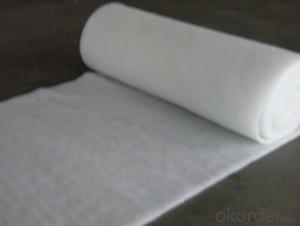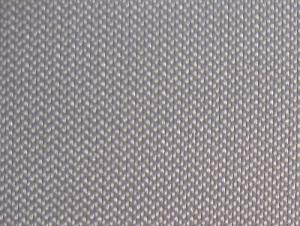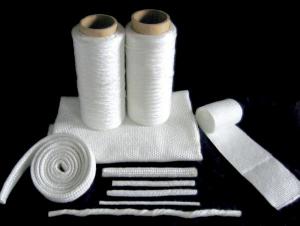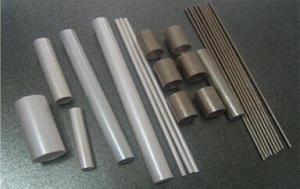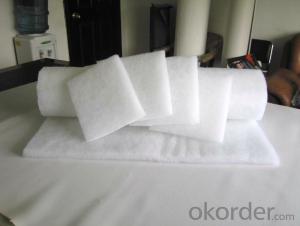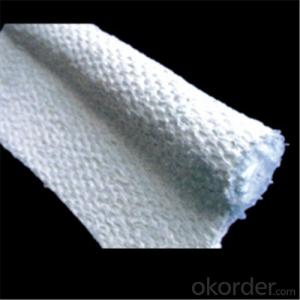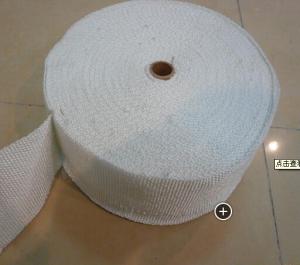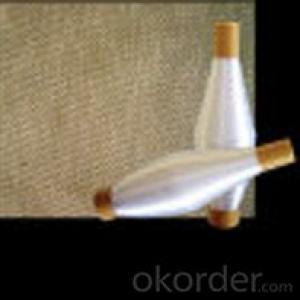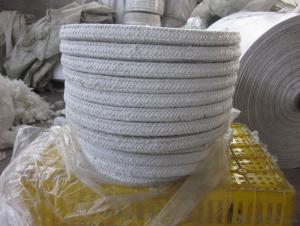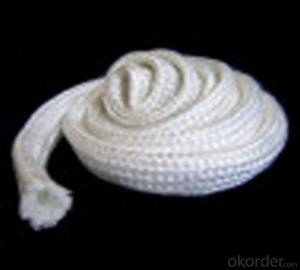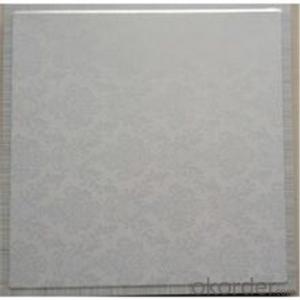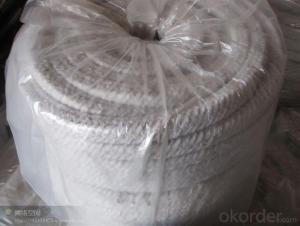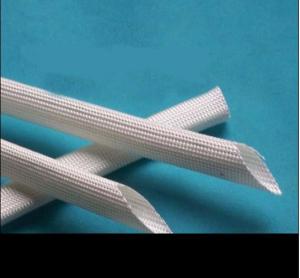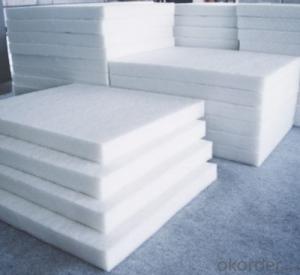Glass Fiber Textiles Refractory Heat Resistant Fiber Fabric
- Loading Port:
- Shanghai
- Payment Terms:
- TT OR LC
- Min Order Qty:
- 1 m.t.
- Supply Capability:
- 111 m.t./month
OKorder Service Pledge
OKorder Financial Service
You Might Also Like
Specifications
1.Refractory heat resistant fiber fabric
2.Heat insulation
3.white
4.High strength
5.MSDS, ISO9001-2008
Refractory Heat Resistant Fiber Fabric
It is a woven fabric made of our high quality ceramic fiber yarns. It can be used for high temperature applications up to1000° C. The cloth is reinforced with fiberglass filament, and optional stainless steel wire. It contains a certain amount of binder material which is normally burned at lower temperature and does not affect the insulation property.
Features of heat resistant fibe fabric
1.Good handling strength
2.Low thermal conductivity and heat storage
3.Excellent thermal shock resistance
4.Easy machining
5.Low weight,eastic, flexible
6.Excellent hydrophobic property
7.Smooth surface and anti-tearing
- Q: Can glass fiber textile be used in water filtration?
- Indeed, water filtration can make use of glass fiber textile. The reason behind its exceptional filtration capabilities lies in its remarkable porosity and diminutive pore size. Consequently, it performs a highly proficient job of eliminating particles, sediments, and impurities from water, rendering it appropriate for diverse water filtration purposes. The significant surface area of glass fiber textile enables the efficient adsorption of pollutants, ensuring the provision of pristine and purified water. Moreover, its chemical resistance and enduring lifespan further establish it as a dependable option for water filtration systems.
- Q: Are glass fiber textiles resistant to wrinkling during washing?
- Yes, glass fiber textiles are generally resistant to wrinkling during washing. Glass fiber is known for its strength and resilience, making it less prone to wrinkling compared to other textile materials. However, it is important to note that the specific properties and characteristics of the glass fiber textile, such as the weave, fabric construction, and finishing treatments, may also affect its wrinkle resistance. It is always recommended to follow the care instructions provided by the manufacturer to ensure proper washing and maintenance of glass fiber textiles.
- Q: Are glass fiber textiles hypoallergenic?
- Glass fiber textiles are generally considered hypoallergenic. Glass fibers are made from inorganic materials, which means they do not contain any organic substances that could trigger allergies. Additionally, glass fibers do not shed or release any particles into the air, making them less likely to cause allergic reactions compared to natural fibers such as cotton or wool. However, it is important to note that individual sensitivities may vary, and some people may still experience allergies or irritations when in contact with glass fiber textiles.
- Q: How to make a fishing boat with fiberglass cloth?
- Do the best wood, plaster mold can also suggest that you go to see some part of the line made of FRP Yacht factory, some two dimensions can be
- Q: Can glass fiber textiles be used for making industrial curtains or partitions?
- Yes, glass fiber textiles can be used for making industrial curtains or partitions. Glass fiber textiles are known for their durability, strength, and ability to withstand high temperatures, making them suitable for industrial applications. They offer excellent resistance to chemicals, fire, and abrasion, providing an effective barrier for partitioning or enclosing industrial spaces. Additionally, glass fiber textiles can offer insulation properties, noise reduction, and are lightweight, making them a versatile choice for creating curtains or partitions in industrial settings.
- Q: Are glass fiber textiles resistant to bacterial or fungal growth?
- Yes, glass fiber textiles are generally resistant to bacterial or fungal growth. Glass fibers are made from inorganic materials, primarily silica, which do not provide nutrients for bacteria or fungi to grow. Additionally, the smooth surface of glass fibers makes it difficult for microorganisms to attach and form colonies. This inherent resistance to microbial growth makes glass fiber textiles a suitable choice for applications where hygiene and cleanliness are important, such as in healthcare facilities, food processing, or cleanrooms. However, it is important to note that while glass fiber textiles themselves are resistant to microbial growth, other components or factors in the surrounding environment may still contribute to bacterial or fungal growth.
- Q: Can glass fiber textiles be used in backpacks and outdoor gear?
- Backpacks and outdoor gear can indeed utilize glass fiber textiles. These textiles, also known as fiberglass fabrics, possess qualities such as being lightweight, durable, and having exceptional strength-to-weight ratios, which make them appropriate for outdoor applications. They offer high tensile strength, resistance to abrasion, and the ability to withstand extreme temperatures. Therefore, they are ideal for use in backpacks and outdoor gear that may encounter rough handling and harsh environmental conditions. Furthermore, glass fiber textiles exhibit good dimensional stability, meaning they retain their shape and are not easily stretched or shrunk. This characteristic is crucial for backpacks and outdoor gear as it guarantees that these items will maintain their form and functionality over time, even when subjected to heavy loads or exposure to moisture. Moreover, glass fiber textiles provide excellent protection against UV rays, rendering them suitable for outdoor gear that is exposed to prolonged sunlight. This aspect is especially significant for backpacks, tents, and other gear used during camping, hiking, or other outdoor activities. Lastly, glass fiber textiles can be coated or treated to enhance their water resistance or flame retardancy, further augmenting their appropriateness for backpacks and outdoor gear. Overall, incorporating glass fiber textiles into backpacks and outdoor gear can offer additional durability, strength, and protection, making them a dependable choice for outdoor enthusiasts.
- Q: How do glass fiber textiles perform in terms of impact resistance?
- Glass fiber textiles are known for their excellent impact resistance. The fibers used in these textiles are made from glass, which is a strong and durable material. This makes them highly resilient to impacts, making them suitable for a wide range of applications where impact resistance is crucial. Glass fiber textiles have a high tensile strength, meaning they can withstand a significant amount of force without breaking or deforming. This property allows them to absorb and distribute the energy from an impact, preventing it from being concentrated on a single point. As a result, glass fiber textiles can effectively resist damage caused by impacts, such as cracks, fractures, or punctures. Moreover, the inherent elasticity of glass fiber textiles contributes to their impact resistance. When subjected to an impact, these textiles can flex and absorb the energy, reducing the risk of breakage. This flexibility also enables them to maintain their shape and structural integrity even after repeated impacts, making them ideal for use in high-impact environments. Furthermore, glass fiber textiles exhibit good resistance to temperature changes, chemicals, and moisture, which further enhances their impact resistance. These textiles can withstand extreme temperatures without losing their structural integrity, making them suitable for use in both hot and cold environments. Additionally, they resist degradation from exposure to various chemicals and moisture, ensuring their durability and impact resistance over time. In summary, glass fiber textiles excel in terms of impact resistance. Their high tensile strength, flexibility, and resistance to temperature changes, chemicals, and moisture make them an excellent choice for applications where impact resistance is crucial. Whether it is in the automotive, aerospace, construction, or sports industries, glass fiber textiles provide reliable protection against impacts, ensuring the longevity and safety of the products they are used in.
- Q: Can glass fiber textiles be knit?
- No, glass fiber textiles cannot be knit as they are made from inorganic materials and lack the flexibility required for the knitting process.
- Q: What are the different surface treatments available for glass fiber textiles?
- Glass fiber textiles offer a range of surface treatments, each serving a specific purpose and providing unique advantages. Some of the most commonly used treatments include: 1. Sizing: During the manufacturing process, a protective coating known as sizing is applied to the glass fibers. This coating enhances the textile's handling and processing characteristics, ensuring better control and stability during weaving or knitting. 2. Silane treatment: By applying a silane coupling agent to the glass fibers, the adhesion between the fibers and various resin systems, such as epoxy or polyester, is improved. This treatment enhances the overall strength and durability of the composite material. 3. Coating: Coating involves applying a layer of protective material, such as acrylic, polyurethane, or silicone, to the glass fiber textile. This adds additional properties like water resistance, UV resistance, or flame retardancy. 4. Laminating: A layer of film or fabric is bonded to the surface of the glass fiber textile in the laminating process. This treatment provides extra strength, stiffness, or decorative effects to the textile, as well as improved resistance to chemicals or abrasion. 5. Dyeing or printing: Dyes or pigments can be used to add color or patterns to glass fiber textiles. Dyeing can be done during manufacturing, while printing involves applying color or designs onto the textile's surface. These treatments enhance the textile's aesthetic appeal and visual appeal. In summary, the various surface treatments available for glass fiber textiles aim to enhance their performance, durability, and appearance. The choice of treatment depends on the specific properties and application requirements of the textile in question.
Send your message to us
Glass Fiber Textiles Refractory Heat Resistant Fiber Fabric
- Loading Port:
- Shanghai
- Payment Terms:
- TT OR LC
- Min Order Qty:
- 1 m.t.
- Supply Capability:
- 111 m.t./month
OKorder Service Pledge
OKorder Financial Service
Similar products
Hot products
Hot Searches
Related keywords
